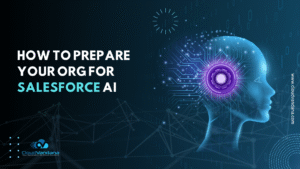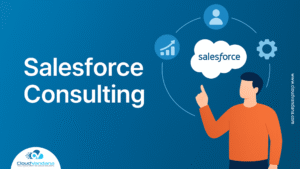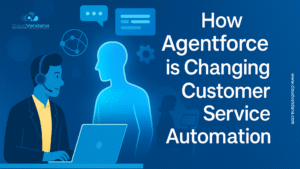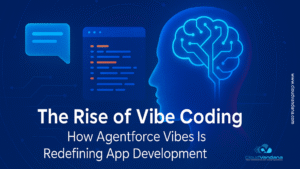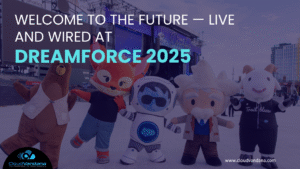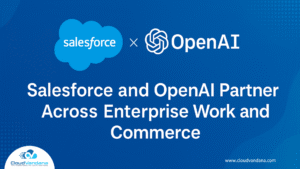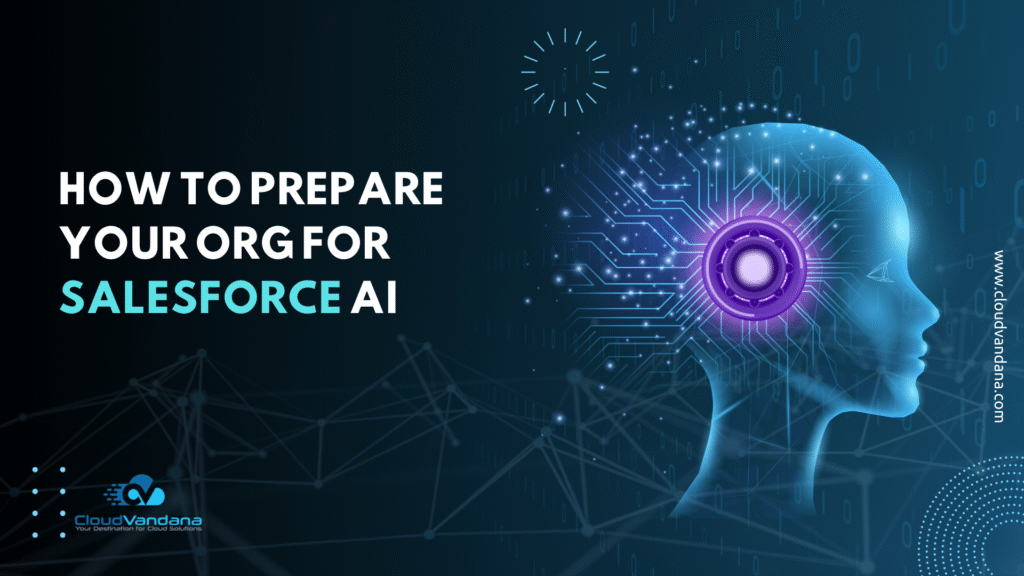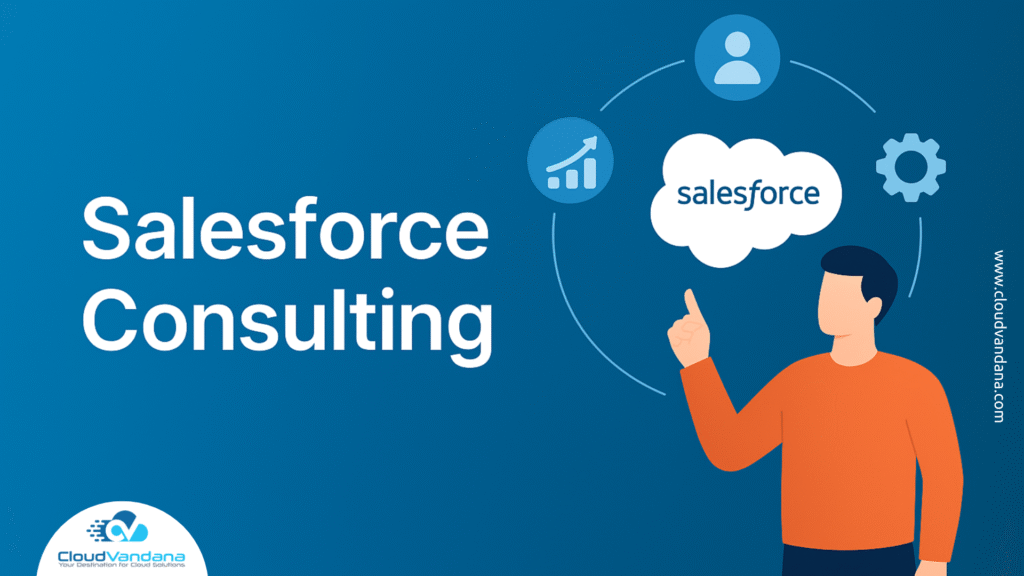The Era of AI-First Salesforce
Salesforce is entering a new era—one defined not by incremental enhancements, but by a fundamental re-engineering of the platform itself. In 2026, Salesforce will operate as an AI-first system, where intelligence is no longer a feature layered on top of workflows, but the very core that drives them. This shift signals the most significant architectural evolution in the platform’s history, and it will reshape how organizations design data, build processes, govern automation, train teams, and deliver customer experiences.
Salesforce AI isn’t just a collection of predictive scores or conversational assistants. It represents a new operating model—one where the platform anticipates actions, identifies risks, surfaces insights, and initiates workflows without waiting for human input. Instead of reacting to user clicks, it interprets business context. Instead of relying on predefined rules, it reasons dynamically using patterns, signals, and unified data. The CRM you once configured will transform into an intelligent system capable of orchestrating interactions across sales, service, marketing, operations, and beyond.
But intelligence comes with prerequisites. AI models depend on clean data, disciplined metadata, modern automations, and architecture that removes ambiguity. They cannot operate reliably on top of years of technical debt, fractured integrations, cluttered objects, or conflicting automations. Companies that fail to prepare will experience inconsistent predictions, unreliable behavior, and user distrust—while those who modernize early will unlock speed, accuracy, and entirely new levels of efficiency.
Preparing for Salesforce AI is no longer optional. It is a strategic imperative. This guide breaks down the core pillars your organization must address—data integrity, automation modernization, governance, integration readiness, security, metadata structure, and user trust—to ensure you enter 2026 with an AI-ready Salesforce org capable of thriving in the next generation of enterprise intelligence.
AI-First vs AI-Enabled: Why the Distinction Matters
It is tempting to think, “We already use Einstein and some AI recommendations — we’re fine.” That mindset is dangerous. AI-enabled means intelligence is sprinkled around the edges of your existing processes. AI-first means intelligence is embedded into the very core of your workflows, data model, and user experiences.
In an AI-enabled org, humans still make most of the decisions and ask most of the questions. AI is a helpful assistant. In an AI-first org, AI is the primary orchestrator of logic. It is constantly scanning behavioral signals, usage patterns, customer journeys, and data changes to decide what should happen next. Humans still approve, override, and refine — but they no longer have to manually initiate every step.
This sounds subtle on paper, but in practice it is transformational. It demands clean, coherent data. It demands well-structured automations. It demands governance that is explicit, not informal. And it demands an architecture designed for adaptability rather than static configuration.ostly mistakes, and build an ecosystem that doesn’t just work today but scales effortlessly into the future.
Table of Contents
- The Era of AI-First Salesforce
- Understanding Salesforce’s AI-First Direction
- The New Reality for Admins and Architects
- Building the Right Data Foundation
- Governance for Responsible AI in Salesforce
- Modernizing Integrations for Real-Time Intelligence
- Rebuilding Automation for the AI Era
- Security, Compliance, and Observability in an AI-First Org
- Budgeting, Resourcing, and Continuous Improvement
- What a 2026-Ready Salesforce Org Looks Like
- Conclusion: Preparing Your Org to Thrive, Not Just Survive
- The New Reality for Admins and Architects
- Building the Right Data Foundation
- Governance for Responsible AI in Salesforce
- Modernizing Integrations for Real-Time Intelligence
- Rebuilding Automation for the AI Era
- Security, Compliance, and Observability in an AI-First Org
- Budgeting, Resourcing, and Continuous Improvement
- What a 2026-Ready Salesforce Org Looks Like
- Conclusion: Preparing Your Org to Thrive, Not Just Survive
- YOU MIGHT ALSO LIKE
Understanding Salesforce’s AI-First Direction
What an AI-First Core Really Implies
When Salesforce speaks of an AI-first core, it is pointing to an architecture where predictive and generative capabilities are tightly woven into objects, flows, data services, and user interfaces. Instead of isolated “AI features,” the platform itself behaves intelligently.
That means:
- Recommendations are not optional add-ons; they are embedded into standard workflows.
- Copilots and assistants are not niche tools; they become common entry points into work.
- Flows and orchestrations are not stand-alone automations; they are driven by model outputs and contextual signals.
In this architecture, AI is not a passenger. It is effectively a second operating system layered on top of your CRM logic.
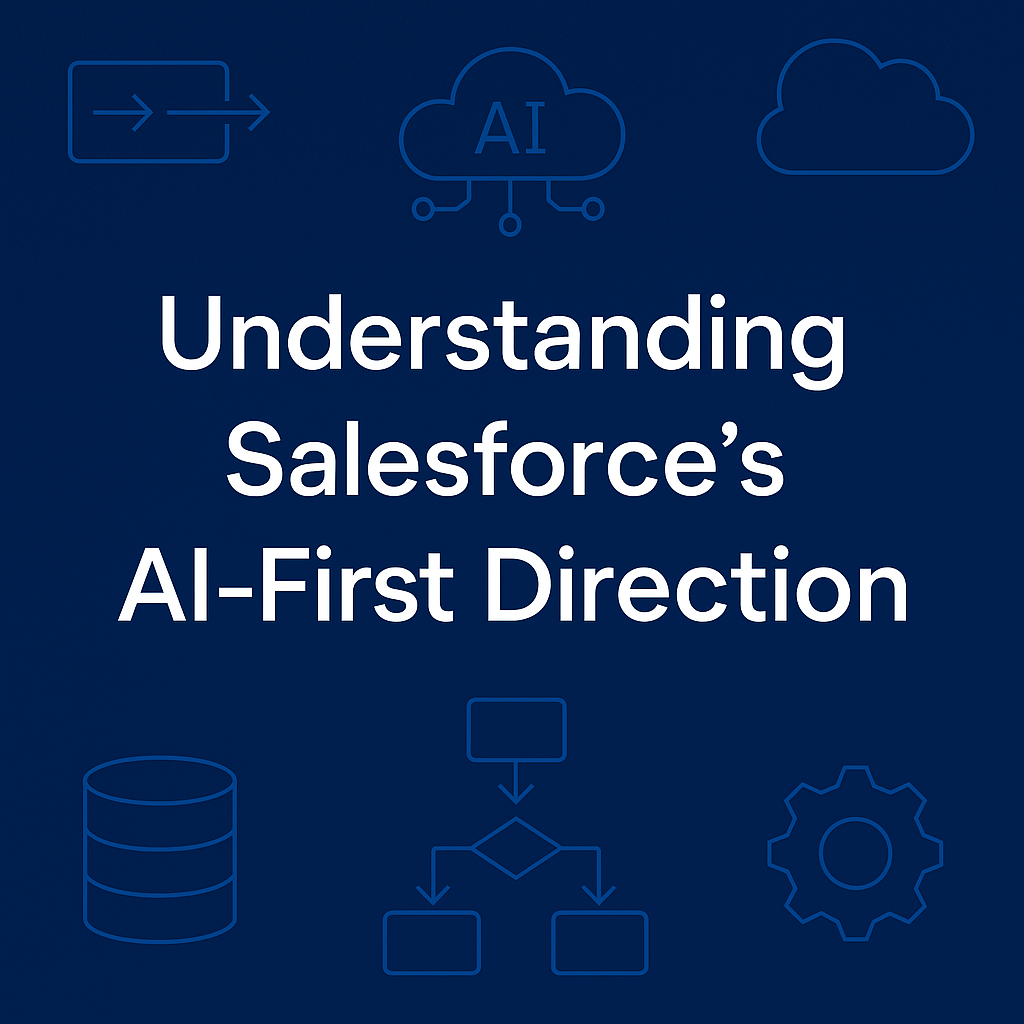
The Technology Backbone Behind the Shift
Under the hood, this shift is powered by several converging capabilities: real-time data unification, scalable model hosting, secure prompt and context handling, and low-code orchestration of AI-driven processes.
You will see:
- Deep alignment between your transactional data and a unified profile in a data layer.
- Models that score, categorize, recommend, and generate content in context, not in isolation.
- Trust and security services that control how prompts, responses, and data are handled.
- Flow and orchestration surfaces that let architects combine events, models, and actions with minimal code.
All of this is extremely powerful — but only if your org is structurally ready to take advantage of it.
Why Legacy Orgs Will Feel the Pain First
Any org that has lived through years of rapid growth, rushed projects, and “just ship it” decisions is likely carrying a heavy load of technical debt. It shows up in ways that AI particularly dislikes:
- Hundreds of unused fields with similar names and unclear purposes.
- Duplicate objects created by different teams at different times.
- Conflicting automations firing on the same events.
- Integrations that move partial data on unreliable schedules.
- ROT (redundant, obsolete, trivial) data inflating volumes and distorting patterns.
Humans can work around this mess. AI cannot. Models need consistency, structure, and signal clarity. If your org is noisy and chaotic, AI will reflect that chaos back at you — in the form of poor recommendations, unreliable predictions, and inconsistent behavior.
The New Reality for Admins and Architects
Moving from Reactive Support to Predictive Stewardship
Traditionally, Salesforce admins have been reactive operators. Something breaks, they fix it. A new requirement appears, they build it. In the AI-first era, the role shifts toward predictive stewardship. Admins will be expected to use telemetry, model outputs, and usage analytics to anticipate issues before they become incidents and to identify opportunities for optimization before business users even ask.
That means watching for:
- Flows that frequently error when invoked by AI-driven triggers.
- Segments or data sets that yield inconsistent recommendations.
- Copilot interactions that suggest confusion or friction in certain processes.
Admins who lean into this new role will become strategic enablers, not just system maintainers.
The Admin Skillset in an AI-First World
To be effective in 2026, admins need a broader, deeper skillset than classic configuration alone. Core capabilities will include:
- Data literacy: Understanding what “good data” looks like and how models consume it.
- Flow and orchestration design: Building modular, maintainable automations that AI can safely trigger.
- Prompt and context tuning: Knowing how to define context and constraints so assistants behave appropriately.
- Governance awareness: Being plugged into rules around data usage, consent, model behavior, and auditability.
In other words, admins must become curators of intelligence, not just builders of forms and fields.
Architects as AI System Designers
For solution and enterprise architects, the expectations rise even higher. They will be responsible for designing end-to-end systems where data, models, automations, external services, and governance all align. An architect who is still thinking only in terms of “objects and integrations” will be behind the curve.
Architects need to:
- Design integration patterns that support event-driven, low-latency AI use cases.
- Define canonical data models that support clear identity resolution and segmentation.
- Choose where AI should be advisory and where it can be autonomous.
- Build a reference architecture that is explicitly AI-ready, not simply “future-proof” in vague terms.
Building the Right Data Foundation
Taking Inventory of Your Data Landscape
No AI-first strategy can succeed if you do not know what data you have, where it lives, and how it moves. That starts with a genuine, structured data inventory across your Salesforce org and its connected systems.
This is not a superficial spreadsheet exercise. It is a systematic assessment that answers questions like:
- Which objects truly matter to core business processes?
- Which systems supply Salesforce with critical data and on what cadence?
- Where do we have duplication, conflicting sources of truth, or inconsistent IDs?
- Which fields are business-critical, and which are legacy remnants no one uses?
Only with this level of visibility can you begin shaping an AI-ready data strategy.
Eliminating Redundant, Obsolete, and Trivial Data
AI models are extremely sensitive to noise. Redundant records, outdated values, and trivial activity clog your signal. When models attempt to find patterns, ROT data drags them away from what is actually meaningful.
Cleaning this up requires courage. It means:
- Archiving historical records that have no analytical value.
- De-duplicating contacts, accounts, and leads at scale.
- Standardizing picklists and eliminating “miscellaneous” text fields.
- Retiring reports, dashboards, and fields that no longer align with current operations.
This type of hygiene has always been beneficial; in an AI-first context, it is non-negotiable.
Structuring Metadata for Machine Understanding
Your metadata — object model, field definitions, relationships, record types, page layouts — is no longer just a convenience layer for humans. It becomes part of the “language” that AI uses to interpret your business.
That means you must bring discipline to areas that may have grown organically over the years:
- Enforce clear naming conventions for objects, fields, flows, and record types.
- Align picklist values to real-world taxonomies rather than ad-hoc labels.
- Design relationships intentionally, reflecting actual business hierarchies.
- Avoid overloading a single object with many competing use cases.
The goal is to create a metadata landscape that is both comprehensible to humans and legible to machines.
The Role of a Unified Data Layer
An AI-first Salesforce ecosystem expects a unified, trusted view of the customer and their interactions. A modern data layer is where identities are resolved, behaviors are stitched together, and segments are defined.
When this layer is well-designed:
- AI can reliably understand “who this person is” across channels and systems.
- Models can detect behavioral patterns tied to segments, not isolated events.
- Copilot and assistants can anchor their responses in a consolidated context.
Preparing your org means investing in this foundation early rather than treating it as an afterthought.
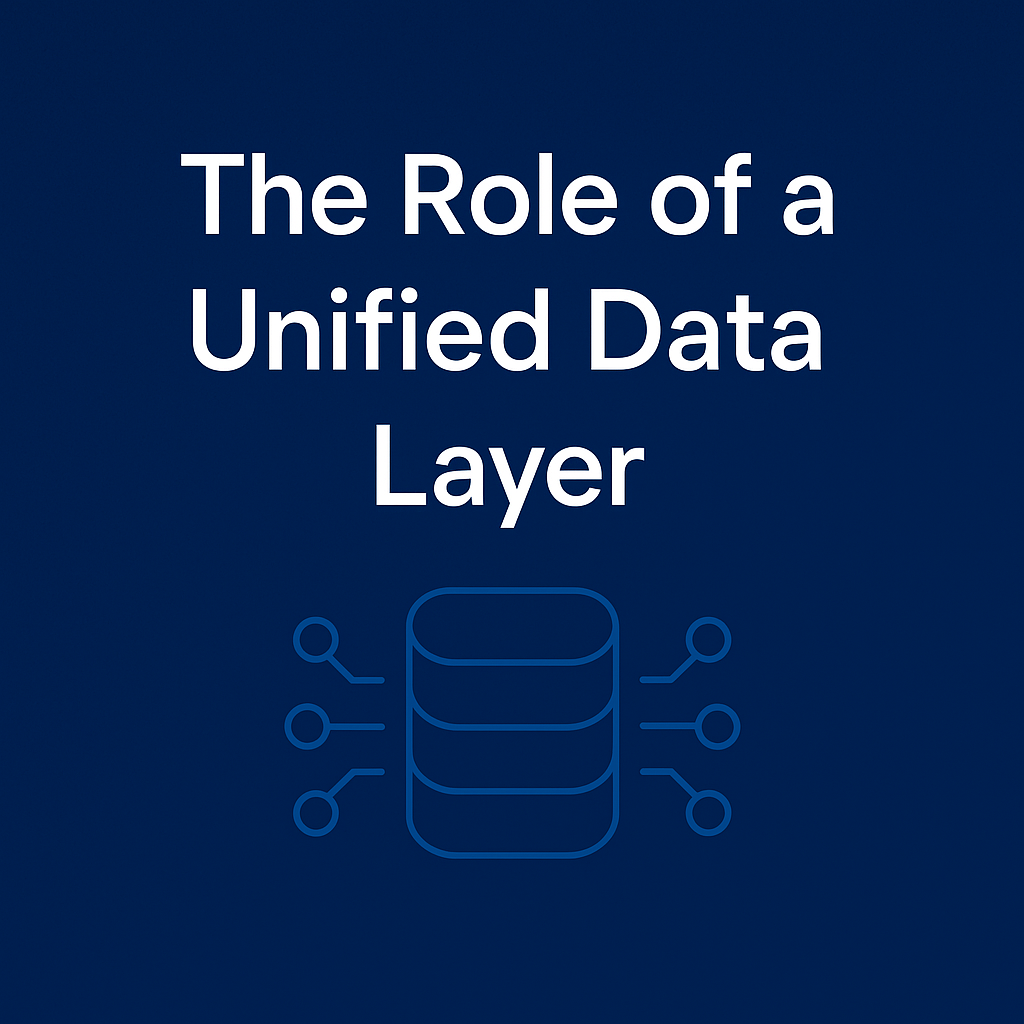
Governance for Responsible AI in Salesforce
Formalizing AI Governance Structures
Once AI becomes embedded in daily workflows, informal governance is no longer sufficient. Organizations need deliberate, documented governance bodies that own decisions about where and how AI is used.
A robust governance model will typically include:
- A cross-functional committee with representation from IT, security, legal, compliance, and business functions.
- A clear intake and approval process for new AI use cases.
- Standards for testing, validating, and monitoring model outputs.
- Policies defining when human review is required before acting on AI outputs.
Without this, AI initiatives can quickly diverge across departments, creating conflicting behaviors and avoidable risk.
Ethics, Transparency, and Explainability
Regulators, customers, and employees are increasingly wary of opaque AI. Your Salesforce AI-first strategy must confront this head-on.
That includes being explicit about:
- Which data attributes are permitted for model training and prediction.
- Which use cases are out-of-bounds because they might be discriminatory or sensitive.
- How users can see, understand, and challenge AI-based decisions affecting their work or customers.
Even inside your organization, frontline teams will be more willing to adopt AI if they understand how it reaches its conclusions, not if it operates like a black box.
Controlling Model Access to Data
One critical element of governance is controlling which subsets of data models can actually see. Just because a data attribute exists in Salesforce does not mean it should be included in an AI prompt, score, or recommendation.
You will need:
- Classification of data by sensitivity and regulatory impact.
- Rules for which classes of data are usable by which AI services.
- Technical enforcement of those rules, not only policy documents.
This is key to avoiding both compliance incidents and reputational damage.
Modernizing Integrations for Real-Time Intelligence
Moving Beyond Batch and Point-to-Point
AI-first Salesforce interactions increasingly require real-time or near-real-time access to data from other systems: billing, ERP, marketing, support platforms, and more. Legacy batch integrations and brittle point-to-point connections will not keep up.
Preparation means:
- Replacing overnight batch loads with streaming or event-driven patterns where appropriate.
- Centralizing integrations on a robust integration platform rather than ad-hoc custom scripts.
- Ensuring external systems can publish and subscribe to the events that AI and flows depend on.
The objective is to ensure that when AI looks at a customer, it sees a current, accurate picture — not last night’s snapshot.
Designing for Event-Driven Behavior
An AI-first architecture thrives in an event-driven environment. When a customer clicks an email link, updates a subscription, disputes an invoice, or opens a support case, that event should be published and available for AI and automation to react to almost immediately.
Architects should:
- Define canonical event types that matter to key journeys.
- Standardize schemas for those events so they can be reused.
- Connect those events to flows, orchestrations, and model triggers inside Salesforce.
The result is a responsive system that feels intelligent, not laggy.
Rebuilding Automation for the AI Era
Retiring Legacy Automation Frameworks
Workflow Rules and Process Builder were fit-for-purpose in a simpler era. They are not appropriate foundations for AI-triggered automation at scale. Maintaining them alongside newer automations increases complexity, risk, and confusion — particularly when AI starts initiating actions.
A serious preparation effort requires:
- Identifying all automations still running on legacy tools.
- Migrating them to standardized, modular Flows.
- Eliminating duplicates or conflicting logic in the process.
Once that cleanup is done, you have a clear, centralized automation layer that AI can interact with safely.
Designing AI-Compatible Flow Architectures
Not all flows are created equal. Many orgs have monolithic, tangled flows that are difficult for humans to understand, let alone for AI-driven triggers to interact with predictably. The AI-first era demands more discipline.
Best practices include:
- Breaking complex logic into reusable subflows.
- Establishing strict naming standards that describe intent, not just object.
- Designing flows around clearly defined entry and exit criteria.
- Building robust, explicit error handling so AI-triggered executions do not fail silently.
AI needs predictable building blocks. The way you structure flows will determine whether AI becomes an asset or a source of instability.
Combining Event Triggers and AI Triggers
In the future, automation won’t only respond to record changes or explicit user actions. It will also be triggered by model outputs and recommendations. These “AI triggers” might signal that a customer is likely to churn, that a lead is ready for outreach, or that a case requires escalation.
A healthy org will intentionally combine:
- Traditional event triggers (record created/updated, platform events, external events).
- AI triggers (high churn risk, anomaly detected, opportunity likely to close, etc.).
Both need to be routed through the same disciplined automation framework so they reinforce each other rather than collide.
Security, Compliance, and Observability in an AI-First Org
Reinforcing Identity and Zero-Trust Principles
When AI can initiate actions and update records, every access path into the platform becomes more sensitive. If identity controls are weak, the blast radius of a compromised account or integration user increases dramatically.
Organizations should:
- Enforce strong multi-factor authentication for all users and integration contexts.
- Segment permissions according to role, not convenience.
- Apply zero-trust principles so every request is validated, not assumed safe.
This is crucial for both human users and machine identities that AI and integrations may rely on.
Understanding Data Residency and Model Boundaries
As AI becomes more central, your regulators and customers will care deeply about where data is stored, how it is processed, and where models run. Some data may need to remain in specific geographies or be segmented by business unit.
Preparation includes:
- Mapping regulatory obligations by region and data category.
- Ensuring your AI configurations respect those boundaries.
- Documenting model usage for audits and vendor assessments.
Telemetry, Logging, and Model Monitoring
Finally, you must be able to see what AI is doing. It is not enough to know that a flow ran; you need to know that it ran because a specific model produced a specific prediction or recommendation.
An AI-first observability strategy will capture:
- Which prompts and contexts are used for AI interactions.
- Which models or scoring mechanisms generated key decisions.
- How often those decisions are accepted, overridden, or corrected by users.
- Where errors, anomalies, or drift appear in model behavior.
This visibility is what allows you to iterate responsibly rather than operate on blind faith.
Budgeting, Resourcing, and Continuous Improvement
Planning for Real Transformation Costs
Too many organizations underestimate the investment required to truly become AI-ready. Licenses are only the starting point. The real costs arise from:
- Data cleansing and de-duplication at scale.
- Rebuilding automation on a modern foundation.
- Refactoring integrations for real-time, event-driven behavior.
- Training teams and redesigning roles.
- Establishing and running AI governance.
Underinvesting almost guarantees a half-implemented AI strategy that frustrates users and leadership alike.
Building the Right Team Mix
To execute well, you need the right combination of skills, whether internal or through partners:
- Salesforce admins trained in data and automation design for AI.
- Architects who can think in terms of events, models, and unified data.
- Data specialists who understand cleansing, cataloging, and segmentation.
- Governance and compliance experts with a handle on AI implications.
Relying on a single overburdened admin team to “figure out AI” is unrealistic and risky.
Establishing a Continuous Improvement Motion
AI-first architecture is not a static destination. Models evolve, patterns shift, and Salesforce will continue to ship new capabilities. Your org must treat AI readiness as a continuous improvement program, not a one-off migration.
A mature organization will:
- Review AI use cases and performance on a regular cadence.
- Decommission experiments that do not deliver value.
- Scale successful patterns across teams and business units.
- Update processes and training as features evolve.
This is how AI transitions from an innovation project to an operational backbone.
What a 2026-Ready Salesforce Org Looks Like
In a mature, AI-ready org, the experience looks very different from today:
- Data across systems is unified, deduplicated, and structured with discipline.
- Users rely on a copilot experience to navigate, create, and decide — rather than hunting through lists and reports.
- Automation is centralized in modular Flows and orchestrations that clearly describe business intent.
- Events from web, product, billing, and support systems inform AI models in near real time.
- Predictions and recommendations are monitored, governed, and continuously improved.
The net effect is a platform that feels less like a CRM and more like an intelligent operating layer for your customer-facing operations.
Conclusion: Preparing Your Org to Thrive, Not Just Survive
Salesforce’s AI-first architecture in 2026 will not wait for organizations to be ready. The platform is moving in that direction with or without your preparation. The question is whether your org will treat this as a disruptive surprise or a planned advantage.
Preparing now means confronting technical debt, investing in your data and integration foundations, modernizing automation, raising your governance game, and elevating the roles of admins and architects into strategic partners in AI adoption.
The organizations that take this seriously will experience more accurate predictions, more efficient teams, faster decision cycles, and a more compelling experience for both employees and customers. Those that ignore it will feel the pain in the form of broken automations, misfiring models, and eroding trust.
An AI-first future is inevitable. A well-prepared Salesforce org is not. That part is entirely in your control.
Understanding Salesforce’s AI-First Direction
What an AI-First Core Really Implies
When Salesforce speaks of an AI-first core, it is pointing to an architecture where predictive and generative capabilities are tightly woven into objects, flows, data services, and user interfaces. Instead of isolated “AI features,” the platform itself behaves intelligently.
That means:
- Recommendations are not optional add-ons; they are embedded into standard workflows.
- Copilots and assistants are not niche tools; they become common entry points into work.
- Flows and orchestrations are not stand-alone automations; they are driven by model outputs and contextual signals.
In this architecture, AI is not a passenger. It is effectively a second operating system layered on top of your CRM logic.
The Technology Backbone Behind the Shift
Under the hood, this shift is powered by several converging capabilities: real-time data unification, scalable model hosting, secure prompt and context handling, and low-code orchestration of AI-driven processes.
You will see:
- Deep alignment between your transactional data and a unified profile in a data layer.
- Models that score, categorize, recommend, and generate content in context, not in isolation.
- Trust and security services that control how prompts, responses, and data are handled.
- Flow and orchestration surfaces that let architects combine events, models, and actions with minimal code.
All of this is extremely powerful — but only if your org is structurally ready to take advantage of it.
Why Legacy Orgs Will Feel the Pain First
Any org that has lived through years of rapid growth, rushed projects, and “just ship it” decisions is likely carrying a heavy load of technical debt. It shows up in ways that AI particularly dislikes:
- Hundreds of unused fields with similar names and unclear purposes.
- Duplicate objects created by different teams at different times.
- Conflicting automations firing on the same events.
- Integrations that move partial data on unreliable schedules.
- ROT (redundant, obsolete, trivial) data inflating volumes and distorting patterns.
Humans can work around this mess. AI cannot. Models need consistency, structure, and signal clarity. If your org is noisy and chaotic, AI will reflect that chaos back at you — in the form of poor recommendations, unreliable predictions, and inconsistent behavior.
The New Reality for Admins and Architects
Moving from Reactive Support to Predictive Stewardship
Traditionally, Salesforce admins have been reactive operators. Something breaks, they fix it. A new requirement appears, they build it. In the AI-first era, the role shifts toward predictive stewardship. Admins will be expected to use telemetry, model outputs, and usage analytics to anticipate issues before they become incidents and to identify opportunities for optimization before business users even ask.
That means watching for:
- Flows that frequently error when invoked by AI-driven triggers.
- Segments or data sets that yield inconsistent recommendations.
- Copilot interactions that suggest confusion or friction in certain processes.
Admins who lean into this new role will become strategic enablers, not just system maintainers.
The Admin Skillset in an AI-First World
To be effective in 2026, admins need a broader, deeper skillset than classic configuration alone. Core capabilities will include:
- Data literacy: Understanding what “good data” looks like and how models consume it.
- Flow and orchestration design: Building modular, maintainable automations that AI can safely trigger.
- Prompt and context tuning: Knowing how to define context and constraints so assistants behave appropriately.
- Governance awareness: Being plugged into rules around data usage, consent, model behavior, and auditability.
In other words, admins must become curators of intelligence, not just builders of forms and fields.
Architects as AI System Designers
For solution and enterprise architects, the expectations rise even higher. They will be responsible for designing end-to-end systems where data, models, automations, external services, and governance all align. An architect who is still thinking only in terms of “objects and integrations” will be behind the curve.
Architects need to:
- Design integration patterns that support event-driven, low-latency AI use cases.
- Define canonical data models that support clear identity resolution and segmentation.
- Choose where AI should be advisory and where it can be autonomous.
- Build a reference architecture that is explicitly AI-ready, not simply “future-proof” in vague terms.
Building the Right Data Foundation
Taking Inventory of Your Data Landscape
No AI-first strategy can succeed if you do not know what data you have, where it lives, and how it moves. That starts with a genuine, structured data inventory across your Salesforce org and its connected systems.
This is not a superficial spreadsheet exercise. It is a systematic assessment that answers questions like:
- Which objects truly matter to core business processes?
- Which systems supply Salesforce with critical data and on what cadence?
- Where do we have duplication, conflicting sources of truth, or inconsistent IDs?
- Which fields are business-critical, and which are legacy remnants no one uses?
Only with this level of visibility can you begin shaping an AI-ready data strategy.
Eliminating Redundant, Obsolete, and Trivial Data
AI models are extremely sensitive to noise. Redundant records, outdated values, and trivial activity clog your signal. When models attempt to find patterns, ROT data drags them away from what is actually meaningful.
Cleaning this up requires courage. It means:
- Archiving historical records that have no analytical value.
- De-duplicating contacts, accounts, and leads at scale.
- Standardizing picklists and eliminating “miscellaneous” text fields.
- Retiring reports, dashboards, and fields that no longer align with current operations.
This type of hygiene has always been beneficial; in an AI-first context, it is non-negotiable.
Structuring Metadata for Machine Understanding
Your metadata — object model, field definitions, relationships, record types, page layouts — is no longer just a convenience layer for humans. It becomes part of the “language” that AI uses to interpret your business.
That means you must bring discipline to areas that may have grown organically over the years:
- Enforce clear naming conventions for objects, fields, flows, and record types.
- Align picklist values to real-world taxonomies rather than ad-hoc labels.
- Design relationships intentionally, reflecting actual business hierarchies.
- Avoid overloading a single object with many competing use cases.
The goal is to create a metadata landscape that is both comprehensible to humans and legible to machines.
The Role of a Unified Data Layer
An AI-first Salesforce ecosystem expects a unified, trusted view of the customer and their interactions. A modern data layer is where identities are resolved, behaviors are stitched together, and segments are defined.
When this layer is well-designed:
- AI can reliably understand “who this person is” across channels and systems.
- Models can detect behavioral patterns tied to segments, not isolated events.
- Copilot and assistants can anchor their responses in a consolidated context.
Preparing your org means investing in this foundation early rather than treating it as an afterthought.
Governance for Responsible AI in Salesforce
Formalizing AI Governance Structures
Once AI becomes embedded in daily workflows, informal governance is no longer sufficient. Organizations need deliberate, documented governance bodies that own decisions about where and how AI is used.
A robust governance model will typically include:
- A cross-functional committee with representation from IT, security, legal, compliance, and business functions.
- A clear intake and approval process for new AI use cases.
- Standards for testing, validating, and monitoring model outputs.
- Policies defining when human review is required before acting on AI outputs.
Without this, AI initiatives can quickly diverge across departments, creating conflicting behaviors and avoidable risk.
Ethics, Transparency, and Explainability
Regulators, customers, and employees are increasingly wary of opaque AI. Your Salesforce AI-first strategy must confront this head-on.
That includes being explicit about:
- Which data attributes are permitted for model training and prediction.
- Which use cases are out-of-bounds because they might be discriminatory or sensitive.
- How users can see, understand, and challenge AI-based decisions affecting their work or customers.
Even inside your organization, frontline teams will be more willing to adopt AI if they understand how it reaches its conclusions, not if it operates like a black box.
Controlling Model Access to Data
One critical element of governance is controlling which subsets of data models can actually see. Just because a data attribute exists in Salesforce does not mean it should be included in an AI prompt, score, or recommendation.
You will need:
- Classification of data by sensitivity and regulatory impact.
- Rules for which classes of data are usable by which AI services.
- Technical enforcement of those rules, not only policy documents.
This is key to avoiding both compliance incidents and reputational damage.
Modernizing Integrations for Real-Time Intelligence
Moving Beyond Batch and Point-to-Point
AI-first Salesforce interactions increasingly require real-time or near-real-time access to data from other systems: billing, ERP, marketing, support platforms, and more. Legacy batch integrations and brittle point-to-point connections will not keep up.
Preparation means:
- Replacing overnight batch loads with streaming or event-driven patterns where appropriate.
- Centralizing integrations on a robust integration platform rather than ad-hoc custom scripts.
- Ensuring external systems can publish and subscribe to the events that AI and flows depend on.
The objective is to ensure that when AI looks at a customer, it sees a current, accurate picture — not last night’s snapshot.
Designing for Event-Driven Behavior
An AI-first architecture thrives in an event-driven environment. When a customer clicks an email link, updates a subscription, disputes an invoice, or opens a support case, that event should be published and available for AI and automation to react to almost immediately.
Architects should:
- Define canonical event types that matter to key journeys.
- Standardize schemas for those events so they can be reused.
- Connect those events to flows, orchestrations, and model triggers inside Salesforce.
The result is a responsive system that feels intelligent, not laggy.
Rebuilding Automation for the AI Era
Retiring Legacy Automation Frameworks
Workflow Rules and Process Builder were fit-for-purpose in a simpler era. They are not appropriate foundations for AI-triggered automation at scale. Maintaining them alongside newer automations increases complexity, risk, and confusion — particularly when AI starts initiating actions.
A serious preparation effort requires:
- Identifying all automations still running on legacy tools.
- Migrating them to standardized, modular Flows.
- Eliminating duplicates or conflicting logic in the process.
Once that cleanup is done, you have a clear, centralized automation layer that AI can interact with safely.
Designing AI-Compatible Flow Architectures
Not all flows are created equal. Many orgs have monolithic, tangled flows that are difficult for humans to understand, let alone for AI-driven triggers to interact with predictably. The AI-first era demands more discipline.
Best practices include:
- Breaking complex logic into reusable subflows.
- Establishing strict naming standards that describe intent, not just object.
- Designing flows around clearly defined entry and exit criteria.
- Building robust, explicit error handling so AI-triggered executions do not fail silently.
AI needs predictable building blocks. The way you structure flows will determine whether AI becomes an asset or a source of instability.
Combining Event Triggers and AI Triggers
In the future, automation won’t only respond to record changes or explicit user actions. It will also be triggered by model outputs and recommendations. These “AI triggers” might signal that a customer is likely to churn, that a lead is ready for outreach, or that a case requires escalation.
A healthy org will intentionally combine:
- Traditional event triggers (record created/updated, platform events, external events).
- AI triggers (high churn risk, anomaly detected, opportunity likely to close, etc.).
Both need to be routed through the same disciplined automation framework so they reinforce each other rather than collide.
Security, Compliance, and Observability in an AI-First Org
Reinforcing Identity and Zero-Trust Principles
When AI can initiate actions and update records, every access path into the platform becomes more sensitive. If identity controls are weak, the blast radius of a compromised account or integration user increases dramatically.
Organizations should:
- Enforce strong multi-factor authentication for all users and integration contexts.
- Segment permissions according to role, not convenience.
- Apply zero-trust principles so every request is validated, not assumed safe.
This is crucial for both human users and machine identities that AI and integrations may rely on.
Understanding Data Residency and Model Boundaries
As AI becomes more central, your regulators and customers will care deeply about where data is stored, how it is processed, and where models run. Some data may need to remain in specific geographies or be segmented by business unit.
Preparation includes:
- Mapping regulatory obligations by region and data category.
- Ensuring your AI configurations respect those boundaries.
- Documenting model usage for audits and vendor assessments.
Telemetry, Logging, and Model Monitoring
Finally, you must be able to see what AI is doing. It is not enough to know that a flow ran; you need to know that it ran because a specific model produced a specific prediction or recommendation.
An AI-first observability strategy will capture:
- Which prompts and contexts are used for AI interactions.
- Which models or scoring mechanisms generated key decisions.
- How often those decisions are accepted, overridden, or corrected by users.
- Where errors, anomalies, or drift appear in model behavior.
This visibility is what allows you to iterate responsibly rather than operate on blind faith.
Budgeting, Resourcing, and Continuous Improvement
Planning for Real Transformation Costs
Too many organizations underestimate the investment required to truly become AI-ready. Licenses are only the starting point. The real costs arise from:
- Data cleansing and de-duplication at scale.
- Rebuilding automation on a modern foundation.
- Refactoring integrations for real-time, event-driven behavior.
- Training teams and redesigning roles.
- Establishing and running AI governance.
Underinvesting almost guarantees a half-implemented AI strategy that frustrates users and leadership alike.
Building the Right Team Mix
To execute well, you need the right combination of skills, whether internal or through partners:
- Salesforce admins trained in data and automation design for AI.
- Architects who can think in terms of events, models, and unified data.
- Data specialists who understand cleansing, cataloging, and segmentation.
- Governance and compliance experts with a handle on AI implications.
Relying on a single overburdened admin team to “figure out AI” is unrealistic and risky.
Establishing a Continuous Improvement Motion
AI-first architecture is not a static destination. Models evolve, patterns shift, and Salesforce will continue to ship new capabilities. Your org must treat AI readiness as a continuous improvement program, not a one-off migration.
A mature organization will:
- Review AI use cases and performance on a regular cadence.
- Decommission experiments that do not deliver value.
- Scale successful patterns across teams and business units.
- Update processes and training as features evolve.
This is how AI transitions from an innovation project to an operational backbone.
What a 2026-Ready Salesforce Org Looks Like
In a mature, AI-ready org, the experience looks very different from today:
- Data across systems is unified, deduplicated, and structured with discipline.
- Users rely on a copilot experience to navigate, create, and decide — rather than hunting through lists and reports.
- Automation is centralized in modular Flows and orchestrations that clearly describe business intent.
- Events from web, product, billing, and support systems inform AI models in near real time.
- Predictions and recommendations are monitored, governed, and continuously improved.
The net effect is a platform that feels less like a CRM and more like an intelligent operating layer for your customer-facing operations.
Conclusion: Preparing Your Org to Thrive, Not Just Survive
Salesforce’s AI-first architecture in 2026 will not wait for organizations to be ready. The platform is moving in that direction with or without your preparation. The question is whether your org will treat this as a disruptive surprise or a planned advantage.
Preparing now means confronting technical debt, investing in your data and integration foundations, modernizing automation, raising your governance game, and elevating the roles of admins and architects into strategic partners in AI adoption.
The organizations that take this seriously will experience more accurate predictions, more efficient teams, faster decision cycles, and a more compelling experience for both employees and customers. Those who ignore it will feel the pain in the form of broken automations, misfiring models, and eroding trust.

Atul Gupta is CloudVandana’s founder and an 8X Salesforce Certified Professional who works with globally situated businesses to create Custom Salesforce Solutions.
Atul Gupta, a dynamic leader, directs CloudVandana’s Implementation Team, Analytics, and IT functions, ensuring seamless operations and innovative solutions.




